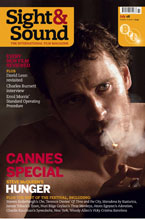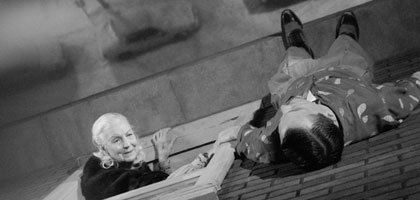
My Winnipeg
Canada/USA 2007

Reviewed by Ryan Gilbey
Synopsis
Our synopses give away the plot in full, including surprise twists.
A documentary in which the Canadian film-maker Guy Maddin muses at length on his home town of Winnipeg - its history, its architecture and its inherent 'sleepiness'. Maddin tries to understand his relationship with Winnipeg by revisiting childhood memories. He moves into the apartment where his family lived while he was growing up, and restages scenes from his youth using actors. He reflects on the demolition of the Winnipeg Arena, where he claims to have been born, and pictures the one thing that would enable him to leave Winnipeg - if 'Citizen Girl', his imaginary pin-up from the Winnipeg Citizen newspaper, restored the city to its former glory.
Review
UK distribution for the films of the avant-garde Canadian director Guy Maddin has been erratic, with only The Twilight of the Ice Nymphs (1997), Dracula: Pages from a Virgin's Diary (2002) and The Saddest Music in the World (2003) earning fully fledged releases here. But even those not fluent in Maddinese will pick up in a flash the director's stylistic lingo in My Winnipeg, a multilayered docu-fantasy that doubles as a nifty Maddin primer. As an onscreen surrogate dozes his way through a never-ending train journey, Maddin fantasises in his italicised, mock-dramatic narration about how best to leave the place where he has spent his life. "What if I film my way out of here?" he wonders, introducing the idea of cinema as psychological liberation, before trying to work through Winnipeg's history and his own, the better to shake it off at last.
In the film's dizziest, most Charlie Kaufmanesque sections, Maddin moves into his childhood home where he stages key moments from his youth using actors as his three siblings (one of whom died aged 16). Ann Savage, scarcely seen since playing the vinegary femme fatale in Edgar G. Ulmer's 1945 Detour, takes the part of their fearsome matriarch. ("Mother is in the moment!" whoops Maddin hilariously when Savage comes up with the goods). With his childhood pet Toby the chihuahua, played by Spanky the pug, looking on, and a lump beneath the living-room carpet representing Maddin's exhumed father, this fake family re-enacts scenes which themselves reflect on the process of re-enactment - particularly the ritual of watching the TV serial 'LedgeMan', in which each episode sees the same highly strung young fellow poised to jump from the window ledge, only to be coaxed indoors by his mother in preparation for a repeat performance the following day. It's a perfectly ripe metaphor for the soothingly repetitious hysteria of family life.
It would be unrealistic to expect conventional dramatic energy from a film this skittish and freeform, which takes in everything from Winnipeg workers' riots to a medium who interprets her messages from the dead in dance. That said, there's quite a kick to the performance of the aptly named Savage. "No matter where I am, I can feel her watching me," complains Maddin, as back-projected footage of her scowling face appears magnified in train windows and she assumes the infantilising omnipresence of the mother in Woody Allen's Oedipus Wrecks (from the New York Stories portmanteau).
Allen's Manhattan is also a clear precursor of My Winnipeg, as are city-based film essays like London or Tokyo-Ga, and especially True Stories, the spaced-out hymn to everyday eccentricity directed by David Byrne of Talking Heads. As with Byrne, Maddin's most skew-whiff ideas - such as the frozen horses sunken in a snow-covered field "like 11 knights on a great white chessboard" - assume a poignancy that outlasts their silliness. Scattershot it might be, but My Winnipeg nudges at the heart of what it means to dream, and how our fantasies of who we are spring from the reality of where we are.
This is articulated most sharply in the revelation of an alternative web of back lanes, known as 'black arteries', that don't appear on any map of Winnipeg - "lanes with names known only by word-of-mouth... illicit things, best not discussed." There's an entire tantalising mythology for this secret network, but its real value lies in contributing another layer to Maddin's wildly fabricated Winnipeg, where veracity matters less than evocation. Who cares if, as Maddin claims, Winnipeg really has ten times the sleepwalking rate of any city in the world? What counts is that the cap fits.
The level of invention in Maddin's writing is so high that there are times when the film's visual style, for all its busyness, lags behind noticeably. The textural collage is appropriately jumbled and hallucinatory: the editing is so frenetic that many shots register only subliminally, while dissolves make the images bleed together into abstract shadows and smudges during a spooky tour of three vertically stacked swimming pools. Noirish monochrome puts up a good fight against colour inserts and burnished shadow puppetry, but this is still a film that rewards the ears more than the eyes. It's no new thing for audiences to be coerced into buying the soundtrack of a film they've just seen. On this occasion, I'm hoping there'll be an audiobook.
Credits
- Directed by
- Guy Maddin
- Producers
- Jody Shapiro
- Phyllis Laing
- Written/Conceived by
- Guy Maddin
- Director of Photography
- Jody Shapiro
- Editor
- John Gurdebeke
- Production Designer
- Réjean Labrie
